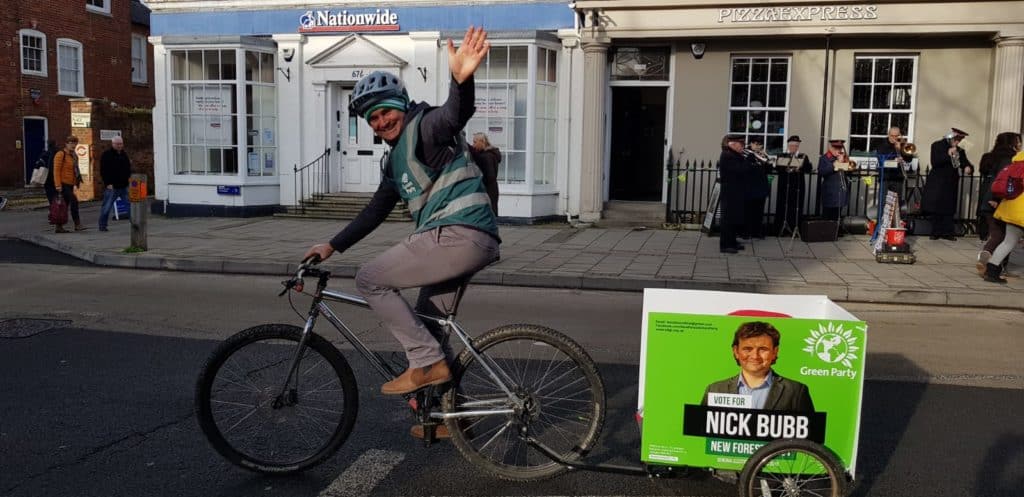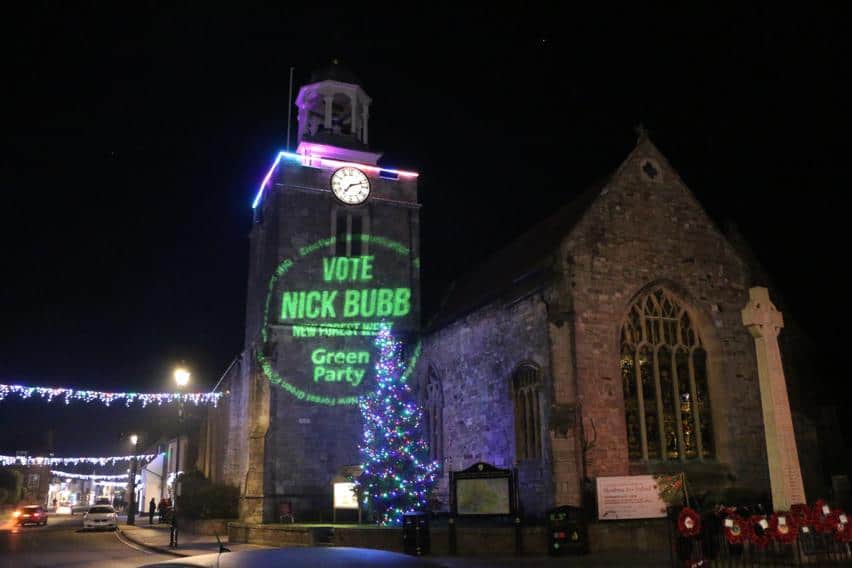
Local success for the New Forest Green’s
I woke up this morning to bittersweet news in the General Election. The Conservatives may have regained a majority in Parliament, but the Green Party also achieved one of it’s best results, including here in the New Forest.
Together with a groundswell of enthusiasm from local members and supporters, our candidates Nick Bubb and Nicola Jolly really did us proud. They met people with intelligence, honesty and respect, and made the case that this election should really be about taking real action on Climate Change.
As a result, Nicola won 4.8% of the vote in New Forest East, double what we achieved in 2017, and Nick Bubb won 7.7% of the vote in New Forest West, our best ever result!
To put this into context, out of the 500 electoral wards where the Green Party stood candidates, our result in New Forest West was the 12th best result, and in New Forest East our result was also well above the national average. In this traditional Conservative stronghold, we’ve demonstrated that the Green Party really can make an impact.

Contributing to national success
The Green Party vote across the UK increased by a massive 60% compared to 2017, showing that voters really are waking up to Green issues. We achieved 2.7% of the vote nationally, with 864,743 votes (second only to our 2015 result of 1.1 million).
Looking at this huge number of votes, we should be celebrating that we now have several MPs in Parliament, but we don’t. We still have just the single seat of Caroline Lucas in Brighton Pavilion – that beacon of hope!
So the question is, does parliament fairly reflect the views of the people? I decided to dig into the data for this election to see how it stacks up. I put it into a spreadsheet that you can view online here, and some of the figures are truly eye opening.
How many MPs should we have?
We have 2.7% of the vote nationally and one MP. But do we have 2.7% of MPs? Well no, we have just 0.15% of MPs. That’s a staggering difference. It’s not even in the same order of magnitude.
If we had a parliament based on proportional representation (PR), then I calculate that we would now have 17 MPs in parliament, which is more than the Liberal Democrats currently have. This would make the Green’s a serious force in British politics.
That said, the Liberal Democrats also suffer under our current system, and under a proportional representation system would now have 75 MPs following this election.
When we break the data down, we find that with the exception of the Brexit Party who won over 600K votes and won zero seats, the Green Party is the least represented party in parliament by a long way. We have only 0.12 seats per 100K votes, compared to the Conservatives and Plaid Cymru, both with 2.61 seats per 100K votes (22 times!), the DUP with 3.28 and Sinn Fein with 3.85. The only party that even comes close to this level of misrepresentation in the voting system is the LibDems with just 0.3 seats per 100K votes.
Who benefits from first past the post?
It is clear that the current system doesn’t work well for the Green Party or the LibDems, but who does it benefit? In my analysis, we can see that five parties benefited from first past the post in this election and 5 parties were detrimented.
Those that benefited were:
- Conservatives (extra 80 seats)
- SNP (extra 22 seats)
- DUP (extra 3 seats)
- Sinn Fein (extra 3 seats)
- Plaid Cymru (extra 1 seat)
Those that suffered were:
- Liberal Democrats (missing 64 seats)
- Green Party (missing 16 seats)
- Brexit Party (missing 13 seats)
- Labour (missing 6 seats)
- Alliance Party (missing 1-2 seats)
- Social Democratic & Labour Party (potentially missing 1 seat)
At first glance, this looks almost perfectly even, both in terms of the number of parties and the number of seats either way. So you would have thought that roughly half of parliament would be in favour of a fairer voting system like proportional representation and half would be against it.
However, these numbers don’t tell the full picture. When you group all MPs by whether they represent a party benefited by first past the post, we find that 431 MPs benefit and only 218 MPs represent parties harmed by first past the post. That’s a 2 to 1 ratio of MPs who have a vested interest in maintaining the first past the post system, compared to those who stand to benefit from proportional representation. Naturally, this creates a majority of parliamentarians who will defend the status quo for their own self-interest instead of support reform to a fairer voting system.
We should also consider that our country has an ingrained cultural belief that only Labour or Conservative’s could win a general election, causing many people to vote for whichever of those two that they see as the lesser evil in order to feel that their vote counts. If the system was designed to actually make everyone’s votes count, it is likely that Labour and the Conservatives would lose significant numbers of votes to smaller parties including the Green’s, potentially giving us far more than 17 MPs.
The voting system isn’t the only thing working against the Green’s
It’s clear that the voting system is radically biased against Green representation in parliament, but there is another significant factor at play. Money!
The Green Party is one of the only parties that is transparent about its financing and doesn’t take large amounts of money from the super rich or big business. The Green Party recognises that even with the best of intentions, money does corrupt. The result is that we have relatively little money to spend on election campaigns.
We don’t yet have data for the 2019 election, but we can get a feel for the impact of money in the election by looking at the party budgets from the 2017 election. According to the electoral commission, the Conservative Party spent £18.6 million, Labour spent £11 million, the Lib Dems spent £6.8 million, the SNP spent £1.6 million and the Green Party spent £299,000. Once again, the difference between the Green’s and the other main parties is an order or magnitude.
This is where the parallel between the Greens and the LibDems ends, as the LibDems have seemingly enormous amounts of money to throw at election campaigning.
If we use the 2017 budgets and apply them to the 2019 election, the data shows us that for all of the five main parties, it costs over £1 to obtain a single vote, with one exception. For the Green Party, it costs just 35p.
You might think it a bit unseemly that I am putting a cost on votes, but the reality is that if spending money on campaigning didn’t work, then nobody would possibly consider spending millions of pounds on it. Election campaigns are marketing campaigns, and those with the deepest pockets have a huge advantage.
The real story here is that you don’t need to spend huge amounts of money to get people to vote Green, but you do have to for other parties. A vote for the Conservatives costs £1.33 and for the LibDems it’s a whopping £1.85. Either they are very bad at marketing, or it is very hard to persuade people to vote for them!
Currently, electoral budgets are restricted by law, to £30K per constituency, but that adds up to a lot when you scale it across the country. It, therefore, has little impact on leveling the playing field. A meaningful restriction would be more like £1000 per constituency (on average), with a national maximum of £650K per party. This would make it very hard for the wealthy to buy the election result, and even without proportional representation, the data suggests that the Green Party would make significant gains compared to other parties on a level financial playing field.
Let’s dream

It is highly frustrating that the electoral system in our country is fundamentally rigged in favour of Labour and the Conservatives, and that the Green Party is one of the worst affected, but considering that, we can look on the bright side and see how well we have done.
Let’s imagine a world in which the playing field is leveled by proportional representation and meaningful limits on election spending. In this imaginary world, we would now have at least 17 Green MPs (with Nick Bubb likely being one). But that’s not it. With people’s votes now counting, we could quite feasibly imagine twice as many people giving their vote to the Green’s, bringing us up to 34 MPs. Then when we factor in that a Green vote costs a quarter of a Conservative vote, even if the Conservatives still spent double what we do, we could double our vote share again, bringing us up to 68 Green MPs.
I know, we are a long way from this imaginary world of real and fair democracy in the UK, but only when we dream it can we create it. Onwards!

